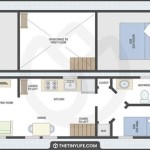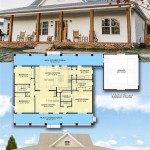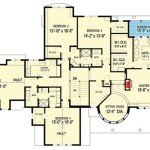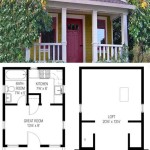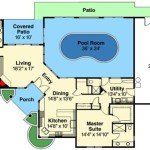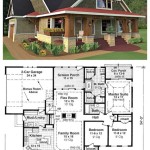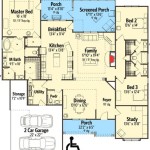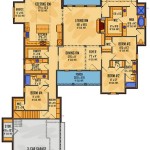5 Bedroom Colonial House Plans: A Comprehensive Overview
Colonial house plans, particularly those designed with five bedrooms, represent a significant segment of the residential architecture market. These designs evoke a sense of history, tradition, and spaciousness, catering to families seeking both aesthetic appeal and functional living spaces. Understanding the nuances of 5 bedroom colonial house plans involves examining their historical roots, characteristic features, interior layouts, advantages, disadvantages, and considerations for selection and modification.
The Colonial architectural style in the United States evolved from various European influences, predominantly English, Dutch, and Spanish, starting in the 17th century. These early forms adapted to the available materials and the climatic conditions of the New World. As settlements grew and prospered, the architectural styles became more refined, leading to distinct regional variations like the New England Colonial, Georgian Colonial, and Southern Colonial. A typical colonial home design will have square or rectangular facades, a symmetrical design, and evenly spaced windows.
The 5 bedroom layout allows for a variety of family configurations, potentially accommodating larger families, multi-generational living, or the need for dedicated guest rooms and home offices. Given the increased square footage required for five bedrooms, these plans often include additional living spaces like formal living rooms, dining rooms, family rooms, and potentially even bonus rooms or finished basements. Careful consideration must be given to the flow and connectivity between these spaces to ensure a functional and harmonious living environment.
Key Features of 5 Bedroom Colonial House Plans
Several defining characteristics distinguish 5 bedroom colonial house plans from other architectural styles. These features often contribute to the overall aesthetic appeal and functionality of the home.
Symmetrical Façade: The most recognizable feature of a colonial home is its symmetrical front elevation. The front door is typically centered, and the windows are evenly spaced on either side. This symmetry extends to the roofline, which is often a simple gable roof with dormers.
Formal Entryway: A prominent entryway with a covered porch or portico is another common feature. This entryway often leads to a formal foyer, which serves as a central hub for the house. The front door is usually decorative, sometimes featuring sidelights and a transom window.
Classic Detailing: Colonial homes are known for their refined detailing, including crown molding, wainscoting, chair rails, and paneled doors. These details add to the sense of elegance and sophistication. Fireplaces with decorative mantels are also frequently found in living rooms and family rooms.
Window Styles: Double-hung windows are the most common type of window used in colonial homes. These windows typically have multiple panes of glass, further enhancing the classic look. Shutters, either functional or decorative, are also frequently added to the windows.
Materials: Traditional colonial homes were built with materials such as wood, brick, and stone. Modern colonial homes may incorporate these materials or use their contemporary equivalents. Siding options include clapboard, shingles, and brick veneer. Roofing materials often include asphalt shingles, wood shakes, or slate.
Interior Layout Considerations for 5 Bedroom Colonial Plans
The interior layout of a 5 bedroom colonial house plan requires careful planning to ensure optimal functionality and comfort. The distribution of living spaces, bedrooms, bathrooms, and service areas must be well-considered.
Bedroom Placement: Typically, the master bedroom is located on the second floor, often with an en-suite bathroom and walk-in closet. The remaining bedrooms are also usually located on the second floor, sharing one or more bathrooms. Consideration should be given to separating the master bedroom from the other bedrooms for added privacy. In some plans, one bedroom may be located on the first floor, potentially serving as a guest room or an in-law suite.
Living Spaces: A formal living room is often located at the front of the house, providing a space for entertaining guests. A family room, typically located off the kitchen, serves as a more casual living space. The kitchen is often the heart of the home, with ample counter space and storage. A separate dining room is typically included for formal meals.
Bathroom Design: With five bedrooms, the number and placement of bathrooms are crucial. Besides the master bathroom, a shared bathroom on the second floor is essential. A half-bath or powder room on the first floor is also highly desirable for guests. The bathrooms should be designed with functionality and aesthetics in mind, incorporating features such as double sinks, separate showers and tubs, and ample storage.
Service Areas: The placement of service areas, such as the laundry room, mudroom, and garage access, should be carefully considered. The laundry room is often located on the second floor for convenience, close to the bedrooms. A mudroom provides a space to store coats, shoes, and other outdoor gear, helping to keep the house clean. Direct access from the garage to the house is also a common feature.
Staircase Design: The staircase is a prominent feature in a colonial home and its design should complement the overall aesthetic. A central staircase, located in the foyer, is typical. The staircase should be well-lit and provide easy access to the second floor.
Advantages and Disadvantages of 5 Bedroom Colonial Homes
Choosing a 5 bedroom colonial house plan involves weighing its potential benefits against its drawbacks to determine if it aligns with personal needs and preferences.
Advantages:
Spaciousness: The primary advantage of a 5 bedroom home is the ample space it provides. This is particularly beneficial for large families or those who require extra rooms for guests, home offices, or hobbies.
Timeless Design: Colonial architecture is renowned for its timeless appeal. The classic lines, symmetrical façade, and refined details create a sense of elegance and sophistication that remains stylish over time.
Resale Value: Colonial homes often hold their value well, particularly in areas where the architectural style is popular. The demand for spacious, well-designed homes with a classic aesthetic can contribute to a higher resale value.
Curb Appeal: The symmetrical façade and traditional details of a colonial home contribute to its attractive curb appeal. This can make the home stand out in the neighborhood and create a positive first impression.
Disadvantages:
Higher Cost: Due to the larger square footage and the inclusion of detailed features, 5 bedroom colonial homes can be more expensive to build or purchase than smaller, simpler homes.
Maintenance: The larger size and the inclusion of intricate details can lead to higher maintenance costs. Features such as wood siding, multiple windows, and decorative molding require regular upkeep.
Energy Consumption: The larger square footage can also result in higher energy consumption for heating and cooling. Older colonial homes may not be as energy-efficient as modern homes, potentially leading to higher utility bills.
Less Flexibility: The formal layout of a traditional colonial home may not be suitable for those who prefer a more open or contemporary design. Modifying the interior layout of a colonial home can be challenging due to its structural constraints.
Selecting and Modifying a 5 Bedroom Colonial House Plan
Choosing the right 5 bedroom colonial house plan involves careful consideration of personal needs, site conditions, and budget. Once a plan is selected, modifications may be necessary to tailor it to specific requirements.
Consider Personal Needs: The first step is to identify the specific needs and preferences of the household. How many bedrooms are needed? What types of living spaces are desired? What is the preferred style of kitchen and bathrooms? Answering these questions will help to narrow down the options.
Assess Site Conditions: The site conditions, including the size, shape, and orientation of the lot, must be taken into account. The house plan should be compatible with the site, taking advantage of natural light and views. The placement of the house on the lot should also consider factors such as drainage, grading, and access to utilities.
Evaluate Budget: The budget is a critical factor in the selection process. The cost of building or purchasing a 5 bedroom colonial home can vary significantly depending on the location, materials, and level of customization. It is important to establish a realistic budget and to stick to it throughout the process.
Review Floor Plans: Carefully review the floor plans to ensure that they meet the needs of the household. Pay attention to the layout of the rooms, the flow of traffic, and the placement of windows and doors. Consider how the spaces will be used and whether they are functional and comfortable.
Consider Modifications: Once a plan is selected, modifications may be necessary to tailor it to specific requirements. Common modifications include adding or removing walls, changing the size or shape of rooms, and adding or modifying windows and doors. It is important to work with an architect or designer to ensure that any modifications are structurally sound and aesthetically pleasing.
Energy Efficiency: Modern building codes emphasize energy efficiency. Consider incorporating energy-efficient features such as high-performance windows, insulation, and HVAC systems. These features can reduce energy consumption and lower utility bills.
Accessibility: If accessibility is a concern, consider incorporating features such as wider doorways, ramps, and accessible bathrooms. These features can make the home more comfortable and convenient for people with disabilities.
In summary, 5 bedroom colonial house plans offer a blend of classic aesthetics and spacious living, making them a desirable option for many families. Careful consideration of the design, layout, advantages, and potential modifications is essential for selecting a plan that effectively meets individual needs and preferences.

House Plan 699 00275 Colonial 5 693 Square Feet Bedrooms Bathrooms Plans Family

Plan 623039dj Traditional 5 Bed Home With Colonial Style Symmetry

Colonial House Plan With 5 Bedrooms And Baths 6161

Traditional 5 Bed Home Plan With Colonial Style Symmetry 623039dj Architectural Designs House Plans

Two Story 5 Bedroom Traditional Colonial Home Floor Plan House Plans Family Blueprints

Colonial Plan 3995 Square Feet 5 Bedrooms 4 Bathrooms Richmond

Colonial Style House Plan 5 Beds Baths 13601 Sq Ft 27 464 Houseplans Com

Colonial Plan 3995 Square Feet 5 Bedrooms 4 Bathrooms Richmond

House Plan 86287 Southern Style With 4263 Sq Ft 5 Bed Bath

Colonial House Plan 5 Bedrms 4 Baths 3126 Sq Ft 126 1168

